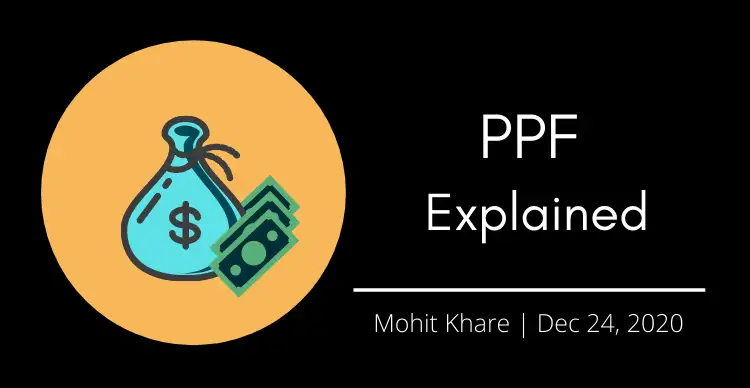PPF Explained

Get latest articles directly in your inbox
After the Term Plan post, lot of folks reached out to me requesting to write more on personal finance. Well, why not? In this post let’s learn about Public Public Provident Fund (popular as PPF). I’ll cover the basics and then deep dive into why and how’s about PPF plan.
I hope this helps you in making better financial decisions. Let’s start!
What is PPF?
Public Provident Fund aka “PPF” is one of the highly popular and investor-friendly saving scheme regulated by Government of India. It is a tax-efficient long term savings plan aimed to encourage investing and specifically for individuals to create a retirement fund.
Details
Any Indian Resident is eligible for PPF plan. (NRIs cannot open unless they already have a PPF account before they left India)
There is no age limit for opening a PPF account.
One can have only 1 PPF account at a time in their life i.e you cannot have more than 1 PPF account at a same time.
Minimum tenure for a PPF account is 15 years. You have to withdraw amount on maturity within 1 year or apply to extend for a minimum term of 5 years but no investments can be made after 15 years. This essentially means that your money is locked in for 15 years.
Amount to be invested
- Minimum amount - Rs 500/year
- Maximum amount - Rs 1,50,000/year
One can make lump-sum deposits but maximum number of deposits per year is 12.
Interest earned from PPF is tax-free and can be redeemed only post maturity.
Default risk is practically zero since this scheme comes under Government of India.
You can take loan against PPF if you hold a PPF account for 3 years. But, maximum loan amount is capped at 25% of PPF balance at time loan was taken. Interest rate for loan will be (1 + prevailing PPF interest rate). So if current PPF rate is say 7% then interest rate for loan will be 8%.
Amount invested in PPF account can be claimed as tax deductions under section 80C upto limit of 1.5 lakhs.
Ideally you cannot withdraw for 15 years. But, there is an option to make a partial withdrawal in case of any emergency form the 7th year onwards. (not before that). You can withdraw upto 50% of your 4th years balance.
If you fail to make a minimum contribution to PPF, your account will be inactive. There is an option to reactivate it by paying a penalty.
How Interest is calculated?
Government defines rate of interest for PPF every quater. Current rate of Interest for Oct-Dec 2020 Quarter is 7.1%.
Interest is calculated on a monthly basis but it is added to PPF balance at end of financial year.
If you don’t invest before 5th of a month you don’t earn interest for that month. So next time you make a PPF deposit make sure you do it before 5th in that month. Monthly interest in (interest_rate/12)%
Here’s a table for you to estimate how much you’ll get at maturity based on fixed investement every year.
| Amount Invested/Year | Maturity Amount (end of 15yrs) |
|---|---|
| 10000 | 271,215 |
| 25000 | 678,036 |
| 50000 | 1,356,070 |
| 100000 | 2,712,139 |
| 150000 | 4,068,208 |
Note: All figures are in Indian Rupee and Rate of Interest is 7.1%
Here’s a PPF calculator just in case you want to play with it.
Why you should invest in PPF?
Retirement Plan
Treat PPF as a investment for retirement where you get a corpus to use which is risk free. Though everyone should invest in PPF, but this is even more useful for non-salaried folks who don’t have EPF (Employee Providend Fund)
Tax Benefits
PPF is a tax-free investment i.e no tax will be charged on interest. Further it provides a relaxation under 80C section of Income tax where you can save upto Rs 1.5lac/year.
Diversification
You invest in Gold, Mutual Funds and Stocks. PPF helps in adding to diversification in your investment. Though equity returns are higher over a long term period but this corpus will be something you are assured of growing at rate of 7-8%
Security
Since PPF is scheme by Goverment of India, it is safe and secure. Also, PPF is immune from any orders by Government.
Where can I Invest?
One can open a PPF account via Post offices or public/private nationalized banks. Most major banks like SBI, Punjab National Bank, HDFC, ICICI, Axis, etc provide an option to open PPF account. Most of these banks have a online facility so you don’t even have to visit a branch.
Once account is open, you can access PPF balance and statement just like any other account.
Documents Required
- Account opening form
- ID proof - PAN card, Aadhaar, Driving license, etc.
- Address proof - Aadhaar, Voter ID, etc.
- Passport size photographs
- Pay slip
- Nomination form
PPF vs FD vs EPF
All are safe form of investment however here are some of the differences between them.
| Factors | PPF | FD | EPF |
|---|---|---|---|
| Interest Rate | ~ 7-8% | ~ 4-6% (can vary) | ~8.5% |
| Lock in Period | 15yrs | upto 10yrs | Till retirement |
| Max. Investment | 1,50,000/year | No limit | No limit |
| Tax Benefits | Tax free | Low tax benefits | Tax free |
Personal Advise
Max out your yearly PPF limit every year if possible i.e Rs 1,50,000
Avoid any withdrawals or loans. Let compounding show its magic on maturity!
Use tax deductions to save tax every year.
Make an investment before 5th of any month.
Automate transactions to transfer money to PPF every month/quarter (again set a date before 5th)
Treat this as a retirement option and don’t lure in for higher returns by other schemes.
Add a nominee to your account.
Resources
I hope you learned something new. Feel free to suggest improvements ✔️
I share regular updates and resources on Twitter. Let’s connect!
Keep exploring 🔎 Keep learning 🚀
Liked the content? Do support :)












